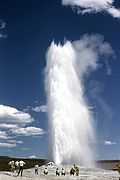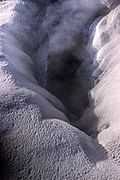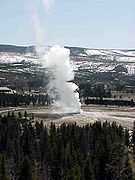Old Faithful is a cone geyser located in Wyoming, in Yellowstone National Park in the United States. Old Faithful was named in 1870 during the Washburn-Langford-Doane Expedition and was the first geyser in the park to receive a name.[3][4] It is also called the most predictable geographical feature on Earth, erupting almost every 91 minutes. The geyser, as well as the nearby Old Faithful Inn, is part of the Old Faithful Historic District.
History
On the afternoon of September 18, 1870
, the members of the Washburn-Langford-Doane Expedition traveled down the Firehole River from the Kepler Cascades and entered the Upper Geyser Basin. The first geyser they saw was Old Faithful. In his 1871 Scribner's account of the expedition, Nathaniel P. Langford wrote:
| “ |
Judge, then, what must have been our astonishment, as we entered the basin at mid-afternoon of our second day's travel, to see in the clear sunlight, at no great distance, an immense volume of clear, sparkling water projected into the air to the height of one hundred and twenty-five feet. "Geysers! geysers!" exclaimed one of our company, and, spurring our jaded horses, we soon gathered around this wonderful phenomenon. It was indeed a perfect geyser. The aperture through which the jet was projected was an irregular oval, three feet by seven in diameter. The margin of sinter was curiously piled up, and the exterior crust was filled with little hollows full of water, in which were small globules of sediment, some having gathered around bits of wood and other nuclei. This geyser is elevated thirty feet above the level of the surrounding plain, and the crater rises five or six feet above the mound. It spouted at regular intervals nine times during our stay, the columns of boiling water being thrown from ninety to one hundred and twenty-five feet at each discharge, which lasted from fifteen to twenty minutes. We gave it the name of "Old Faithful." |
” |
|
In the early days of the park, Old Faithful was often used as a laundry:
| “ |
Old Faithful is sometimes degraded by being made a laundry. Garments placed in the crater during quiescence are ejected thoroughly washed when the eruption takes place. Gen. Sheridan's men, in 1882, found that linen and cotton fabrics were uninjured by the action of the water, but woolen clothes were torn to shreds.[5] |
” |
|
Eruptions

16-second video clip of an eruption
Eruptions can shoot 3,700 to 8,400 US gallons (14,000 to 32,000 L) of boiling water to a height of 106 to 185 feet (32 to 56 m) lasting from 1.5 to 5 minutes. The average height of an eruption is 145 feet (44 m).[6] Intervals between eruptions can range from 45 to 125 minutes, averaging 66.5 minutes in 1939,[7] slowly increasing to an average of 90 minutes apart today.[8] The time between eruptions has a bimodal distribution.
More than 137,000 eruptions have been recorded. Harry Woodward first described a mathematical relationship between the duration and intervals of the eruptions (1938).[7][9] Old Faithful is not the tallest or largest geyser in the park; that title belongs to the less predictable Steamboat Geyser.[4] Its popularity is more likely due to the small eruption window and high frequency.
Increasing interval
Over the years, the length of the interval has increased, which may be the result of earthquakes affecting subterranean water levels. These disruptions have made the earlier mathematical relationship inaccurate, but have in fact made Old Faithful more predictable. With a margin of error of 10 minutes, Old Faithful will erupt 65 minutes after an eruption lasting less than 2.5 minutes or 91 minutes after an eruption lasting more than 2.5 minutes. The reliability of Old Faithful can be attributed to the fact that it is not connected to any other thermal features of the Upper Geyser Basin.[10]
Measurement
Between 1983 and 1994, four probes containing temperature and pressure measurement devices and video equipment were lowered into Old Faithful. The probes were lowered as deep as 72 feet (22 m). Temperature measurements of the water at this depth was 244 °F (118 °C), the same as was measured in 1942. The video probes were lowered to a maximum depth of 42 feet (13 m) to observe the conduit formation and the processes that took place in the conduit. Some of the processes observed include fog formation from the interaction of cool air from above mixing with heated air from below, the recharge processes of water entering into the conduit and expanding from below, and entry of superheated steam measuring as high as 265 °F (129 °C) into the conduit.[11]
Gallery
| Images of Old Faithful Geyser |
|---|
| Photo by W. H. Jackson, 1892 |
| Color, Photochromatic print, 1898 |
| Old Faithful on the 1916 Haynes Guide |
| From Observation Point, 2003 |
|
References
- ↑ "Old Faithful". Yellowstone Geothermal Features Database. Montana State University.
- ↑ "Old Faithful". Geographic Names Information System, U.S. Geological Survey.
- ↑ Bauer, Clyde Max (1947). Yellowstone Geysers. Yellowstone Park, Wyoming: Haynes, Inc. OCLC 1517713.
- ↑ 4.0 4.1 "Old Faithful Geyser". Old Faithful Area Tour. National Park Service.
- ↑ Winser, Henry J. (1883). The Yellowstone National Park-A Manual for Tourists. New York: G.P. Putnam Sons. p. 46.
- ↑ Chapple, Janet (2005). Yellowstone Treasures. Providence, RI: Granite Peak Publications. p. 79. ISBN 0-9706873-1-1.
- ↑ 7.0 7.1 Clyde Max Bauer and George Marler (1939). "Old Faithful, An Example of Geyser Development in Yellowstone Park". Northwest Science 13: 50–5.
- ↑ "Old Faithful". Geyser Observation and Study Association. http://www.geyserstudy.org/geyser.aspx?pGeyserNo=OLDFAITHFUL.
- ↑ Harry R. Woodward (1939). "Season Report on the Naturalist Activities at Old Faithful Station.".
- ↑ "Old Faithful slows, but grows". Billings Gazette. Archived from the original on October 9, 2007. Retrieved July 21, 2007.
- ↑ Hutchinson RA, Westphal JA, and Kieffer SW (1997). "In situ observations of Old Faithful Geyser". Geology 25 (10): 875–878. Bibcode:1997Geo....25..875H. doi:10.1130/0091-7613(1997)025<0875:ISOOOF>2.3.CO;2.
External links
|
|---|
| | | | Geysers | | |
|---|
| | Hot Springs | |
|---|
| | Lone Star Geyser Basin | |
|---|
| | Structures and History | |
|---|
| | Geography | |
|---|
|
- List of Yellowstone National Park related articles
-
 Media related to Upper Geyser Basin at Wikimedia Commons Media related to Upper Geyser Basin at Wikimedia Commons
|
|
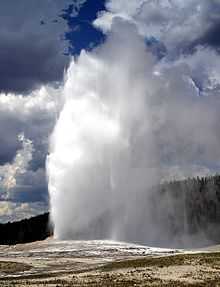
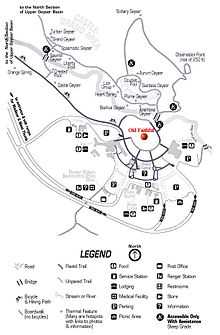

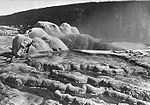

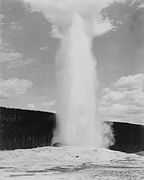

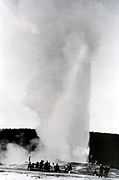
.jpg)


